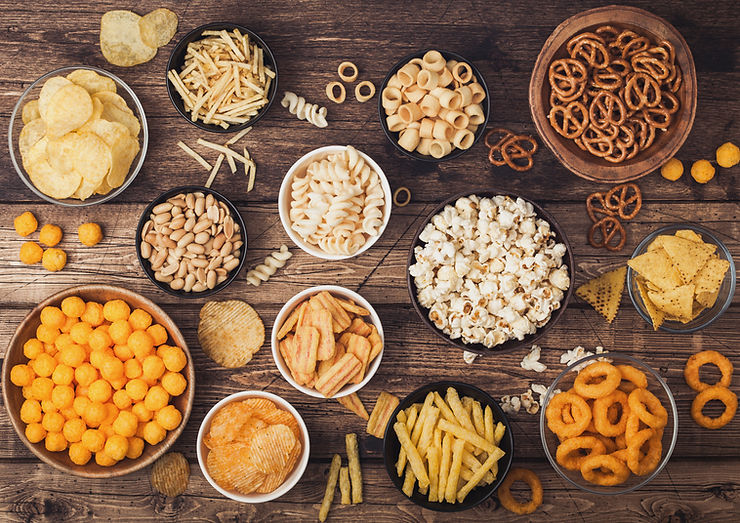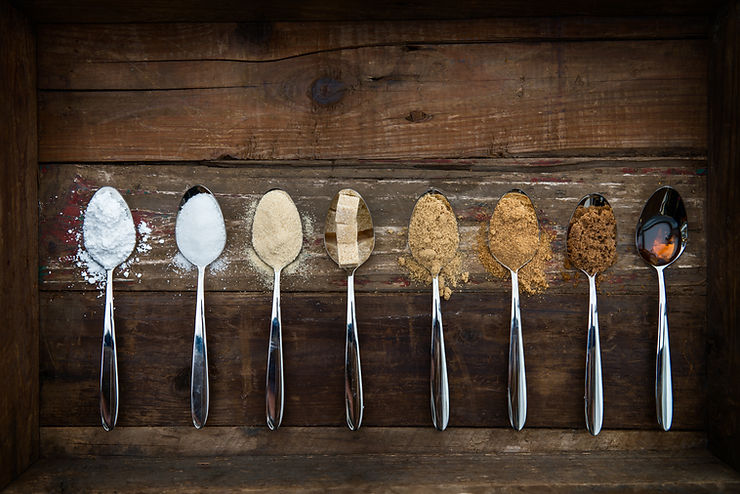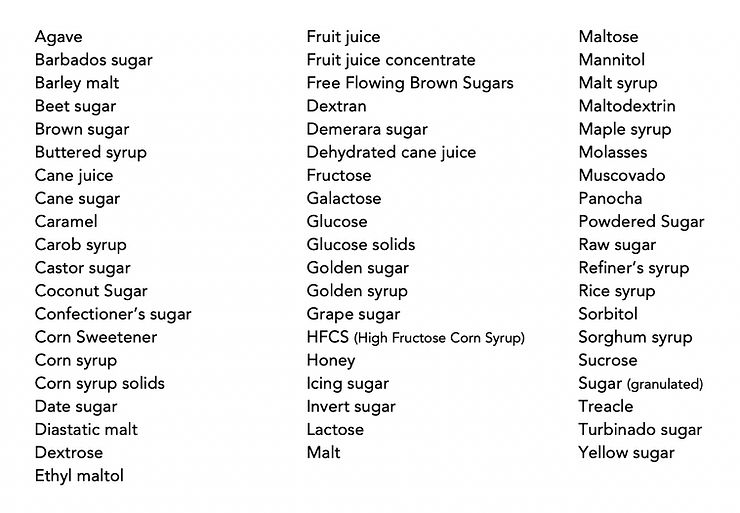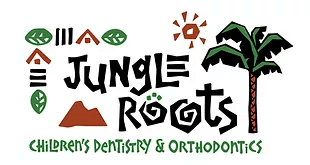Hidden Sugar in Kid’s Foods
We all know that too much sugar causes cavities and gingivitis.
Unfortunately, even if you don’t allow your child to eat treats, they can still consume a ton of sugar from foods you would never think of as sweet foods.
Pretzels, potato chips, goldfish crackers, yogurt, apple sauce, and cereal bars can be full of sugar.
Even if your child never consumes sweets, the hidden sugars in “healthy” foods may easily put them over the recommended daily limit.
Just as eating too many sweets can cause cavities, regularly consuming other foods with added sugar will also increase the risk of developing cavities.

The World Health Organization (WHO) recommends that you consume no more than 10% of your daily calories from free sugar (this includes added sugar). Dr. Francesco Branca, Director of WHO’s Department of Nutrition for Health and Development, stated that “We have solid evidence that keeping intake of free sugars to less than 10% of total energy intake reduces the risk of overweight, obesity and tooth decay.” Less than 10% of a 2,000 calorie diet is approximately 6 teaspoons, or 25 grams of sugar a day. They go on to state that health benefits increase if you keep the total amount below 5%.
So, what is added sugar? How can you tell if it is in a food?
What about all these other types of sugar that people claim are healthier, like honey, maple syrup, and coconut sugar. Are they really any better?
Is any sugar okay?
Sugar is not all bad. It is a type of carbohydrate that your body breaks down quickly to use as energy, make proteins, or store. You do need natural sources to survive. Your brain cells and red blood cells can only use glucose (a type of sugar found in plants and honey) for energy. This means that without natural sources of glucose you, quite literally, would die!
If you eat sugar in dairy, fruits, and vegetables, you are also consuming all the other nutrients that are good for you. One example is the calcium you get from dairy products, which is vital for healthy teeth. Fruits and vegetables contain fiber that slows the rate of digestion, reducing the harmful effects that too much sugar can have on your body. Crisp fruits and vegetables actually help clean your teeth while you chew them.
What is added sugar?
The problem begins when you add any type of sugar, whether it is added by the manufacturer, cook, or consumer. This means that any honey or syrup you put on your food or in your coffee or tea is considered added sugar. Fruit juice is also a source of free sugar because you have removed the fiber.
Some people claim that molasses, agave, maple syrup, honey, or coconut sugar are better for you than white table sugar. Some of them do contain nutrients or have a lower glycemic index, which means that your blood sugar doesn’t spike as high, lowering the risk of diabetes.
However, all these types of sugars are made up of varying amounts of sucrose, glucose, and fructose, the exact same types of sugar found in white sugar and high fructose corn syrup. (Sucrose is simply a combination of glucose and fructose.) Regularly eating any of these sources of sugar will have a harmful effect on your teeth and gums.
Common sources of hidden sugar.
Sugar is added to the strangest things. Let’s use a turkey sandwich as an example. If you make a turkey sandwich with bread, turkey lunchmeat, cheese, mayonnaise, mustard and lettuce, your child is eating hidden sugar. Depending on the brands that you use, the bread, mayonnaise, and even the turkey probably have added sugar! If you give your kids chips and applesauce to go with the sandwich, chances are they are eating even more sugar before they get to dessert.
One example of so-called “healthy” foods packed with added sugar are cereal, granola, and protein bars. The amounts of sugar vary slightly depending on the flavor, but here are examples of a few of the most popular brands. Nutri-Grain bars each have 12 grams of sugar, full-sized Clif bars have around 20 grams, the kid’s version of Clif bars have around 10 grams, and Nature Valley granola bars have around 11 grams. If you consider that an older child should not have more than 25 grams of added sugar a day, one of these bars will use up a significant portion of the recommended limit.
A 20 oz. Gatorade contains 34 grams of sugar. So, if your teenager’s snack during a game is a Gatorade and Clif bar, they more than doubled their daily allowance of sugar in that one snack.

Another way to think of it that makes it easier to understand is converting the idea of grams to teaspoons. 4 grams of sugar equals approximately 1 teaspoon of sugar. So, a 20 oz. Gatorade with 34 grams and a Clif bar with 20 grams contains a total of 54 grams of sugar. Divide that by 4 and your child had about 13 teaspoons of sugar!
Many other foods that don’t seem sweet at all still often contain added sugar. Even foods labeled organic or healthy can have tons of added sugar. Here are just a few:
- Apple Sauce
- BBQ Sauce
- Bread
- Canned Fruit
- Canned or Bottled Tea
- Canned Vegetables
- Cereal
- Cereal Bars
- Chips
- Crackers
- Dried Fruit
- Flavored Milk
- Flavored Popcorn
- Fruit Leather
- Granola
- Granola Bars
- Instant Oatmeal
- Juice
- Ketchup
- Pasta Sauces
- Peanut Butter
- Pretzels
- Ranch (and most salad dressings)
- Smoothies
- Soup
- Sport Drinks
- Yogurt
Tips to reduce sugar.
One of the most helpful things you can do is learn how to read a food label. There are many different names for sugar. Ingredients are listed by amount, so if a type of sugar is high on the list there is going to be a lot of it in the food.
Switch to brands that have fewer, or zero, added sugars. Keep in mind that just because zero grams of sugar are listed under the nutrition facts doesn’t mean that there truly is no sugar. There may still be less than a gram of sugar. In this case, if you look at the ingredient list, it may include one of the names for sugar near the bottom of the list.
Rather than eating flavored oatmeal, yogurt, granola, etc., get a plain, no-sugar-added version and use fruit, spices, and extracts to flavor them. Cinnamon, clove, and nutmeg are wonderful spices to add flavor and a bit of sweet, as are vanilla, almond, and hazelnut extracts.
If you try to remove sugar from your child’s diet all at once, you may have a battle on your hands. Slowly make changes and they will get used to less sweetness without it being as noticeable. Eventually, they will be eating far less sugar.
If your child is old enough to understand, enlist him or her in helping make the change. Let your child help you search food labels and pick items with no added sugar. A sense of ownership in the process may help gain their cooperation.
Be a role model. A child is much more likely to go along with the change if you are part of it as well.
If you have the time and energy, try making homemade versions. Usually, more processed foods have much higher amounts of hidden sugar.
Instead of snacking on crackers, chips, and packaged foods, switch to fruits, vegetables, nuts, seeds, and cheese. (Be sure to check labels. Even packaged peanuts and sunflower seeds can have added sugars!)
How to find hidden sugar.
Hidden sugar is not always easy to identify. It can be called many different things on food labels. Here is a list to help you find out if your foods have hidden sugar.

We all want our kids to have a healthy mouth and avoid cavities. Even if you teach your child to have impeccable oral hygiene, a diet high in added sugar can still cause cavities. Unfortunately, all the hidden sugars in food make it more difficult to eliminate sugar than you may wish.
Hopefully, the information we provided can help you start taking control of your family’s sugar consumption. If you have any questions or concerns, we are always happy to help!

At Jungle Roots Children’s Dentistry & Orthodontics, we strive to provide the highest comprehensive pediatric and orthodontic dental care in a unique, fun-filled environment staffed by a team of caring, energetic professionals. We believe the establishment of a “dental home” at an early age is the key to a lifetime of positive visits to the dentist.


















